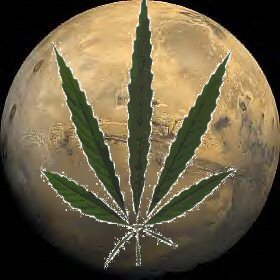
Here's some of my thoughts on producing a cannabis variant for Martian cultivation. The rhetorical comments are in response to the high;y political nature of...a plant.
Yield from aquaponics would have to approach the yield of Terran hemp in soil per square meter.
Hydroponic yields of marijuana per square meter is significantly less than that of hemp in soil in the same space. Based on what literature you read, on average you can grow a range of 200-300 hemp plants while you yield arount 10 -12 marijuana plants per square meter. Sure comparing hemp to marijuana is an " apples & oranges" thing. However, given the lack of studies on growing hemp in water culture (hydroponics, aeroponics & aquaponics), it's all that I can find available to gauge yield. That's why research in this area is critical.
It would also have to yield close to Terran hemp in terms of local temperature and atmospheric pressure.
From what I've read, hemp fiber yield decreases with lower temperatures and higher altitudes.
Hemp could be slowly cross-bred over time in continuously changing environments until it can be as close to whatever the Martian greenhouse conditions will be.
There have never been any human-rated structures built for long term habitation on another planet. So will the greenhouses on Mars sport temperatures & lower pressures found in spacecraft, or closer to that of the International Space Station? Or will research show that in order to be economically viable for the settlements, cannabis will require it's own separate greenhouse? Again, nobody knows.
Water & nutrient uptake would have to be adjusted for Mars gravity.
There's about three decades worth of plant research studies done in microgravity, with a significant portion of it still untranslated in Russian. That database points the way on how to proceed. The only way to specifically work on this is with hard data from plants grown in an on-orbit experiment package.
Now we enter the frustrating political realm of the International Space Station.
Even though you can have these experiments performed there as simply as using small plastic shopping bags as planters (major kudos to the brilliant high school students who came up with that one), that order of simplicity requires a $100 billion space station, astronauts doing it for the PR value thereby not charging their services for station resources, and every bit of ISS infrastructual support.
A few posts ago I mentioned NASA's free research plan, but you have to get it there.
And to run it " for free" , it would have to be completely autonomous once on-line. Unless you need to have a human work with it. Then NASA charges something like $15,000 per hour to do so. Or if you need to use their power, water, telemetry, computer network, etc. .
In reality, nothing is free on the ISS, the USA rules the roost, and NASA has final say on what goes up there. I'm pretty confident that the US government is not going to allow this research on board. Even if it was proposed by more hemp-friendly ISS partner nations like Canada or France.
So we're left with DIY university-class microsatellite use. Works for me.
Loss of crop yield due to infestation by indigenous vectors may not be factor. Resistance to molds, & possibly any bacteria from human exhalation and fish (via water from the aquaponic system) must be considered.
Due to the irrational political nature that nations have placed on Cannabis Sativa L. and it's subvariations, it's tragic that the possibility that terrestrial pests could be introduced on Mars as a deliberate act of interplanetary state-sponsored bio-terrorism must be seriously taken into account. Makes me wonder if The Big Four (Energia, ESA, JAXA, NASA) modeled this possiblity in their long-term space greenhouse studies?
Long term storage & radiation protection must be developed to keep the initial seed stock viable en route to Mars.
Here's another wonderful area of hard core engineering research that can be done on a micro-satellite level.
Sunday, September 16, 2007
On Martian Hemp
Thursday, September 13, 2007
AB 684 Passes in California - UC Davis as Mars Hemp Central?
A wonderful opportunity has appeared for areo-agricultural cannabis research within the United States.
On September 11th by a 26-13 vote, the California legislature passed AB 684, the California Industrial Hemp Farming Act. The bill now goes to the Governor for signing.
According to Section 1g of the Act, within four pre-selected counties in the stste of California to produce hemp; Imperial, Kings, Mendocino & Yolo, agricultural hemp research can be conducted under strict criteria.
The perfect choice for this research would be Yolo County's UC Davis College of Agricultural and Environmental Sciences. Not only does it perfectly fit the criteria set by the Act as a research facility, ironically Davis, California is also the home of celebrated Mars Trilogy author Kim Stanley Robinson.
But the Act has a built-in expiration date. Unless otherwise put into law, this act will automatically be repealed on 01 January 2013.
Also by no later than 01 January 2012, the Hemp Industries Association must report no later than 01 January 2012 to subcomittees of agriculture & pubic safety the economic impact of this act.
Within this time frame, along with fundamental research on growing hemp (not marijuana) aquaponically (which to date I can't find any research ever done), the real business of research and development could begin on producing a hemp variant for use in martian greenhouses.



